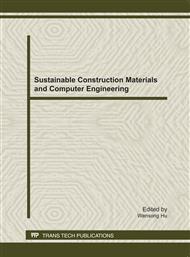p.405
p.412
p.419
p.426
p.433
p.440
p.447
p.455
p.460
Coupled Dynamic Analysis of a Spar Type Floating Wind Turbine
Abstract:
Floating wind turbine is drawn great attention for deepwater wind energy, and some concepts have been proposed. Dynamic response is of great importance for design and analysis. In this paper, the validated fully coupled analysis code HARP is employed to analyze a spar type concept. The wind turbine is modeled as a wind block with certain thrust coefficient, and the hydrodynamic parameters are calculated using WAMIT. The mooring system is modeled using FEM method and analyzed based on elastic rod theory. The performance of this system is calculated in time domain including the coupled aero-hydrodynamic effect. The simulation is taken under certain design load cases, and primary characteristics are given both in time history and statistics. The results indicate that the concept has excellent performance and HARP could be an effective tool for floating wind turbine design and analysis.
Info:
Periodical:
Pages:
433-439
Citation:
Online since:
September 2011
Authors:
Price:
Сopyright:
© 2012 Trans Tech Publications Ltd. All Rights Reserved
Share:
Citation:


